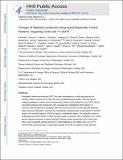Therapy of Myeloid Leukemia using Novel Bispecific Fusion Proteins Targeting CD45 and 90 Y-DOTA
Author(s)
Orozco, Johnnie J; Kenoyer, Aimee L; Lin, Yukang; O'Steen, Shyril; Guel, Rosario; Nartea, Margaret E; Hernandez, Alexandra H; Hylarides, Mark D; Fisher, Darrell R; Balkin, Ethan R; Hamlin, Donald K; Wilbur, D Scott; Orcutt, Kelly D; Wittrup, K Dane; Green, Damian J; Gopal, Ajay K; Till, Brian G; Sandmaier, Brenda; Press, Oliver W; Pagel, John M; ... Show more Show less
DownloadAccepted version (1.015Mb)
Open Access Policy
Open Access Policy
Creative Commons Attribution-Noncommercial-Share Alike
Terms of use
Metadata
Show full item recordAbstract
© 2020 American Association for Cancer Research. Pretargeted radioimmunotherapy (PRIT) has been investigated as a multi-step approach to decrease relapse and toxicity for high-risk acute myeloid leukemia (AML). Relevant factors including endogenous biotin and immunogenicity, however, have limited the use of PRIT with an anti-CD45 antibody streptavidin conjugate and radiolabeled DOTA-biotin. To overcome these limitations we designed anti-murine and anti-human CD45 bispecific antibody constructs using 30F11 and BC8 antibodies, respectively, combined with an anti-yttrium (Y)-DOTA single-chain variable fragment (C825) to capture a radiolabeled ligand. The bispecific construct targeting human CD45 (BC8-Fc-C825) had high uptake in leukemia HEL xenografts [7.8 = 0.02% percent injected dose/gram of tissue (% ID/g)]. Therapy studies showed that 70% of mice with HEL human xenografts treated with BC8-Fc-C825 followed by 44.4 MBq (1,200 mCi) of 90Y-DOTA-biotin survived at least 170 days after therapy, while all nontreated controls required euthanasia because of tumor progression by day 32. High uptake at sites of leukemia (spleen and bone marrow) was also seen with 30F11-IgG1-C825 in a syngeneic disseminated SJL murine leukemia model (spleen, 9.0 = 1.5% ID/g and bone marrow, 8.1 = 1.2% ID/g), with minimal uptake in all other normal organs (<0.5% ID/g) at 24 hours after 90Y-DOTA injections. SJL leukemia mice treated with the bispecific 30F11-IgG1-C825 and 29.6 MBq (800 mCi) of 90Y-DOTA-biotin had a survival advantage compared with untreated leukemic mice (median, 43 vs. 30 days, respectively; P < 0.0001). These data suggest bispecific antibody–mediated PRIT may be highly effective for leukemia therapy and translation to human studies.
Date issued
2020Department
Massachusetts Institute of Technology. Department of Biological EngineeringJournal
Molecular Cancer Therapeutics
Publisher
American Association for Cancer Research (AACR)